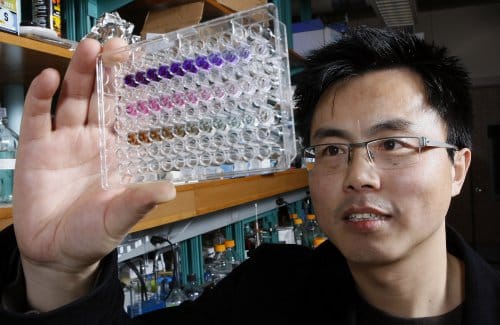An innovative nanopolymer prepared at Purdue University (Indiana, USA) will allow scientists who develop drugs to test their effectiveness faster and cheaper.
 An innovative nanopolymer prepared at Purdue University (Indiana, USA) will allow scientists who develop drugs to test their effectiveness faster and cheaper.
An innovative nanopolymer prepared at Purdue University (Indiana, USA) will allow scientists who develop drugs to test their effectiveness faster and cheaper.
The researcher W. Andy Tao, a professor of biochemistry and analytical chemistry at Purdue University (Indiana, USA) has developed a nanopolymer that can determine whether or not anticancer drugs will be effective against biochemical processes that are responsible for the development of a cancer cell. The nanopolymers will attach themselves to target proteins that can then be detected using a relatively simple laboratory method called chemiluminescence - emission of light at low temperatures following chemical reactions [chemoluminescence] (The term on Wikipedia).
The new nanopolymers are coated with titanium ions and they are attracted to and bind to phosphorylated proteins, those proteins to which a phosphorylated group has been added and whose function is to activate an enzyme called kinase. It has long been known that overactivity of this enzyme, kinase, is responsible for the formation of a cancer cell, and many anticancer drugs focus on inhibiting the activity of this enzyme.
"Our method is universal. It is possible to detect any type of phosphorylation that occurred in the protein," notes the researcher. "Also, our method is cheaper and can be particularly useful." The research findings were published in the scientific journal Analytical Chemistry.
How does the method work? The nanopolymers are added to the solution containing the proteins, a chemical responsible for initiating the phosphorylation and a drug that inhibits the activity of the enzyme (kinase). Phosphorylated proteins will only be found if the drug is ineffective. The Avidin-HPR system is also added to the solution - the avidin protein associated with the horseradish peroxidase enzyme. The protein avidin binds to vitamin B acid known as biotin, which is found on the surface of the nano-polymer. A chemical known as a substrate, which is added to the system later, will initiate a reaction with the enzyme red peroxidase and eventually change the color of the solution.
A light-colored solution would indicate that there was low kinase activity and that there was a low concentration of phosphorylated proteins - that is, the drug was effective. A darker solution will indicate higher kinase activity and less efficacy of the drug. "Our method could be extremely useful in the fields of pharmacy and in the discovery of new drugs," notes the researcher.
Searching and finding kinase inhibitors using antibodies may be a limited method for many laboratories due to its high cost, since the amount of antibodies is low and they are not available for many cell types. Radioisotope tests involve multiple limitations and can be dangerous as a result of the radiation involved. "Our intention was to develop a method that could be a commercial application that would replace the radioisotopic and antibody methods as a universal method for searching and finding kinase inhibitors," the lead researcher clarifies.
